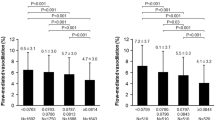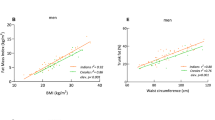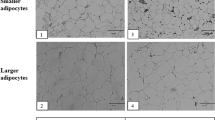Abstract
OBJECTIVE: To ascertain in obesity the role of body fat distribution (the strongest predictor of morbility and mortality in obese subjects) in determining the degree of endothelial dysfunction, an early marker of atherosclerotic disease.
SUBJECTS: 18 premenopausal women with uncomplicated obesity excluding other cardiovascular risk factors and 12 age-matched slim healthy women.
MEASUREMENTS: Endothelium-dependent vasodilation, studied as diameter variation in response to an increase in shear-stress, was evaluated in the right common femoral artery of obese and slim subjects by a non invasive approach and compared to glyceril-trinitrate vasodilation. To characterize better the vascular functional and/or structural properties, we studied the arterial wall distensibility by an echo-tracking system. Adipose tissue regional distribution was determined by computerised axial tomography.
RESULTS: The endothelium-dependent vasodilation was significantly impaired in obese subjects (P<0.005 versus non-obese subjects) while glyceril-trinitrate vasodilation and arterial distensibility were similar in the two groups. In our obese subjects endothelial-dependent vasodilation was inversely correlated to body fat distribution (visceral/subcutaneous adipose tissue ratio: r=− 0.624, P=0.0058). In contrast, metabolic parameters (except C-peptide response during oral glucose tolerance test (OGTT): r=−0.587, P=0.01), blood pressure values and body weight did not correlate with the endothelial function.
CONCLUSION: Uncomplicated obesity per se is characterised by an alteration of the endothelial function; the degree of this vascular damage is predicted by body fat distribution independently of body weight and metabolic and other haemodynamic parameters, and correlates with an index of insulin secretion.
This is a preview of subscription content, access via your institution
Access options
Subscribe to this journal
Receive 12 print issues and online access
$259.00 per year
only $21.58 per issue
Buy this article
- Purchase on Springer Link
- Instant access to full article PDF
Prices may be subject to local taxes which are calculated during checkout
Similar content being viewed by others
Author information
Authors and Affiliations
Rights and permissions
About this article
Cite this article
Arcaro, G., Zamboni, M., Rossi, L. et al. Body fat distribution predicts the degree of endothelial dysfunction in uncomplicated obesity. Int J Obes 23, 936–942 (1999). https://doi.org/10.1038/sj.ijo.0801022
Received:
Revised:
Accepted:
Published:
Issue Date:
DOI: https://doi.org/10.1038/sj.ijo.0801022
Keywords
This article is cited by
-
The role of nitric oxide (NO) levels in patients with obstructive sleep apnea-hypopnea syndrome: a meta-analysis
Sleep and Breathing (2021)
-
Beneficial effects of cherry consumption as a dietary intervention for metabolic, hepatic and vascular complications in type 2 diabetic rats
Cardiovascular Diabetology (2018)
-
Cardiovascular co-morbidity in patients with rheumatoid arthritis: a narrative review of risk factors, cardiovascular risk assessment and treatment
BMC Rheumatology (2018)
-
Obesity and hypertensive heart disease: focus on body composition and sex differences
Diabetology & Metabolic Syndrome (2016)
-
Abdominal obesity and cardiometabolic risk in children and adolescents, are we aware of their relevance?
Nutrire (2016)



